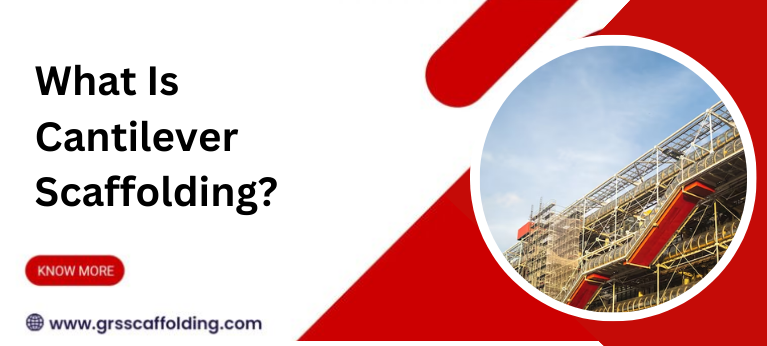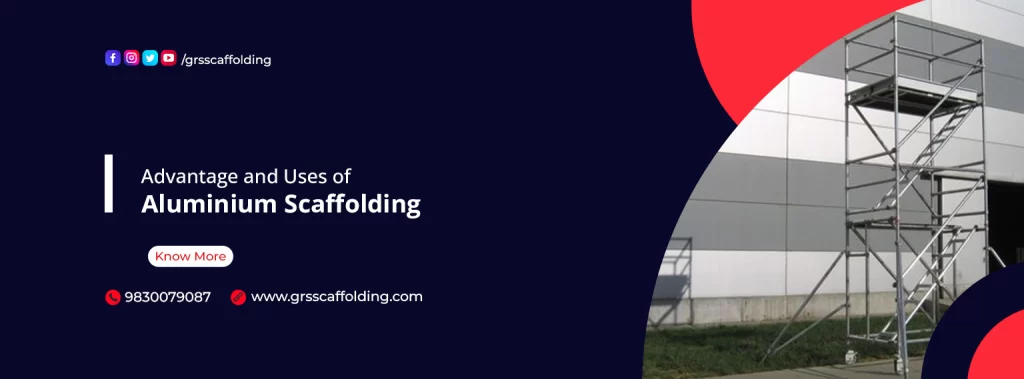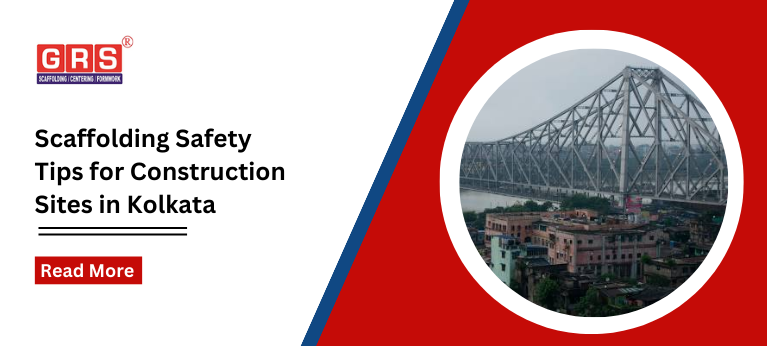Cantilever scaffolding is a crucial element in the construction and maintenance industry, providing unique solutions for accessing hard-to-reach areas.
In this comprehensive guide, we’ll explore the intricacies of cantilever scaffolding, from its basic definition to its applications, advantages, and structural calculations.
What is Cantilever Scaffolding?
Cantilever scaffolding is a specialized scaffold structure designed to extend horizontally beyond its support base. Unlike traditional scaffolding where supports are directly beneath the platform, cantilever scaffolding employs horizontal beams, or needles, supported by the building or structure itself.
What is a Cantilever Truss Scaffold?
A cantilever truss scaffold is a variation of cantilever scaffolding that incorporates truss elements for added stability. Trusses, composed of triangular frames, enhance the structural integrity of the scaffold, making it suitable for heavier loads and more complex construction projects.
Features of a Cantilever:
Cantilever scaffolding is distinguished by its unique design and key components, each contributing to its functionality and versatility. Here are the notable features of a cantilever scaffold:
- Needles:
- Horizontal beams extending from the building.
- Support the platform, allowing it to project outward.
- Brackets:
- Attachments connecting needles to the building.
- Provide stability and support to the horizontal beams.
- Platform:
- The working surface for construction and maintenance activities.
- Typically made of steel planks for durability and strength.
- Guardrails:
- Safety barriers installed along the edges of the platform.
- Prevent falls and enhance worker safety during elevated work.
- Adjustability:
- Cantilever scaffolding is adjustable to accommodate different building structures.
- The length of needles and the placement of brackets can be modified based on project requirements.
- Versatility:
- Suitable for a variety of construction and maintenance tasks.
- Provides access to areas that may be challenging with traditional scaffolding.
- Space Efficiency:
- Efficient use of limited space as the support structure is set away from the working area.
- Ideal for projects where space constraints are a consideration.
- Ease of Installation:
- The design is relatively straightforward, allowing for quicker installation.
- Reduces downtime and enhances overall project efficiency.
The features of a cantilever scaffolding, including its needles, brackets, platform, guardrails, adjustability, versatility, space efficiency, and ease of installation, collectively make it a valuable tool in the construction and maintenance industry.
Whether working on facades, windows, or other elevated areas, the distinct characteristics of cantilever scaffolding contribute to its effectiveness and adaptability on diverse projects.
Where Can We Use Cantilever Scaffolding?
Cantilever scaffolding, with its unique design and versatility, finds wide-ranging applications in the construction and maintenance industry. Here’s a closer look at where we can use cantilever scaffolding to overcome challenges and access hard-to-reach areas.
Facade Maintenance:
Cantilever scaffolding is particularly well-suited for tasks involving the maintenance and enhancement of building facades. Whether it’s painting, repairs, or the installation of windows, the horizontal extension of the scaffold allows workers to reach elevated surfaces with ease. This application is crucial in preserving the aesthetics and structural integrity of buildings.
Construction Projects:
In construction, accessing specific areas of a building under construction can be a logistical challenge. Cantilever scaffolding proves invaluable in such scenarios. It allows workers to reach intricate sections of a structure, facilitating tasks like concrete pouring, masonry work, or the installation of structural elements that might be challenging with conventional scaffolding.
Renovations and Restorations:
When working on renovations or restoring historical structures, cantilever scaffolding offers a solution for navigating intricate architectural details. Its ability to extend horizontally without obstructing the work area makes it a preferred choice for projects where preserving the original design is crucial.
Bridge Construction and Maintenance:
Bridges often present unique challenges in terms of accessibility, especially when it comes to maintenance and repair work. Cantilever scaffolding proves beneficial for bridge projects, enabling workers to reach spans and structural components efficiently, ensuring the safety and longevity of these vital transportation structures.
High-Rise Building Projects:
The construction and maintenance of high-rise buildings demand specialized solutions. Cantilever scaffolding becomes an indispensable tool in such projects, allowing workers to access different levels and sections of the building’s exterior. Its adaptability to varying heights makes it an efficient choice for vertical construction endeavors.
Advantages of Cantilever Scaffolding:
Cantilever scaffolding stands out as a versatile and effective solution in the construction and maintenance industry, offering several distinct advantages that contribute to its widespread use. Explore the key benefits that make cantilever scaffolding a preferred choice in various projects.
Versatility In Access:
One of the primary advantages of cantilever scaffolding is its ability to provide access to challenging areas that may be difficult to reach with traditional scaffolding. By extending horizontally beyond its support base, cantilever scaffolding allows workers to navigate around obstacles, facilitating work on facades, high-rise structures, or intricate architectural elements.
Space Efficiency:
Cantilever scaffolding optimizes space utilization, a crucial factor in construction sites with limited working areas. Unlike conventional scaffolding that requires vertical supports directly beneath the working platform, cantilever scaffolding’s design allows for a more compact footprint. This feature proves invaluable in congested urban environments or projects with spatial constraints.
Quick Installation And Dismantling:
The straightforward design of cantilever scaffolding translates to quicker installation and dismantling processes. The system typically involves horizontal beams (needles), brackets, and a stable platform.
This simplicity not only accelerates project timelines but also enhances overall efficiency, making cantilever scaffolding an attractive choice for time-sensitive construction and maintenance tasks.
Enhanced Visibility and Accessibility:
Cantilever scaffolding provides an unobstructed view of the work area, allowing for better visibility and control over construction or maintenance activities. The absence of vertical supports directly beneath the platform eliminates potential obstructions, enabling workers to focus on their tasks without hindrance. This feature enhances both safety and productivity on the job site.
Cost-Effective Solution:
In many scenarios, cantilever scaffolding can be a cost-effective solution. Its efficient use of materials and quicker installation times contribute to potential cost savings. Additionally, the adaptability of cantilever scaffolding may reduce the need for additional specialized equipment or alternative access solutions, further contributing to overall project cost-efficiency.
The advantages of cantilever scaffolding make it a valuable asset in the construction and maintenance toolkit. Its versatility, space efficiency, quick installation, and adaptability to complex structures contribute to its widespread use, proving instrumental in efficiently addressing the unique challenges posed by diverse projects.
How To Calculate Cantilever Span:
Calculating the cantilever span is a critical aspect of engineering and construction, requiring careful consideration of various factors to ensure structural integrity and safety. The cantilever span is determined by assessing the material strength, load-bearing capacity, and overall structural design.
Engineers typically begin by evaluating the properties of the materials used in the construction of the cantilever, considering factors such as tensile strength and elasticity. Additionally, understanding the expected load on the cantilever is essential, as it directly influences the permissible span length.
Structural engineers employ mathematical calculations and modeling techniques to analyze the forces acting on the cantilever and ascertain the maximum span that can be safely achieved. By marrying material science with structural engineering principles, professionals can determine an optimal cantilever span that meets the specific requirements of a given project, ensuring both functionality and safety.
How To Calculate Cantilever Beams:
Calculating cantilever beams involves a careful assessment of the structural elements to ensure stability and load-bearing capacity. The process begins by understanding the expected load distribution on the cantilevered section.
Engineers consider factors such as the type of load, its magnitude, and the point of application. Next, material properties play a crucial role in the calculation. The strength and elasticity of the materials used in the construction of the cantilever beam determine its overall structural integrity.
Engineers use mathematical models and principles of structural analysis to assess the bending moments, shear forces, and deflections within the cantilever. By considering these factors, engineers can determine the appropriate dimensions and material specifications to ensure that the cantilever beam can safely support the intended loads without compromising structural integrity.
Careful calculations are essential to guarantee the reliability and safety of cantilever beams in various construction and engineering applications.
Conclusion:
Cantilever scaffolding is a versatile and efficient solution in the construction and maintenance industry. Understanding its features, applications, advantages, and structural considerations is crucial for ensuring safe and effective use in various projects. Whether it’s reaching heights during construction or maintaining facades, cantilever scaffolding plays a pivotal role in accessing challenging work areas.
Faq of Cantilever Scaffolding:
Safety is paramount when using cantilever scaffolding. It is essential to adhere to industry safety standards and guidelines. Proper installation, regular inspections, and the use of personal protective equipment are crucial to ensure a safe working environment.
Yes, cantilever scaffolding is adjustable to accommodate different building structures and requirements. The length of the needles and the placement of brackets can be adjusted to suit the specific needs of the project.
While cantilever scaffolding is versatile, its suitability depends on the specific requirements of the project. Factors such as building design, load-bearing capacity, and the nature of the work being performed will determine whether cantilever scaffolding is the most appropriate choice.
The effectiveness of a cantilever scaffold depends on the specific requirements of the project. Cantilever scaffolding is a valuable solution when access to certain areas is challenging, offering versatility and space efficiency. When properly installed and used in accordance with safety guidelines, it can be a reliable and effective choice for construction and maintenance projects.
The maximum length of a cantilever slab depends on several factors, including the material used, load-bearing capacity, and structural design. In construction engineering, the length of a cantilever is often determined by analyzing the structural integrity and ensuring it meets safety standards. Engineers and architects assess factors such as the type of material, the purpose of the cantilever, and the load it will bear to determine the appropriate maximum length.



